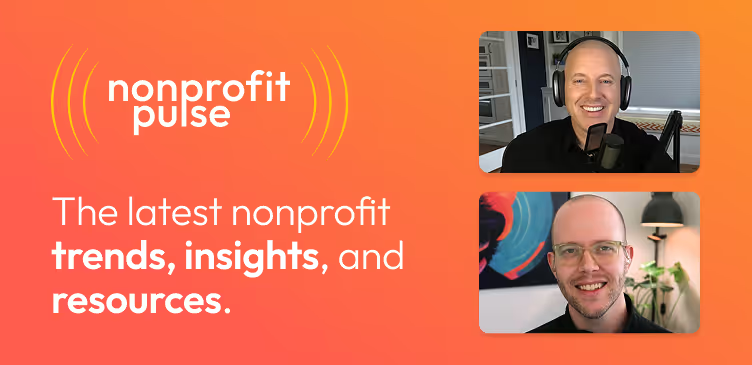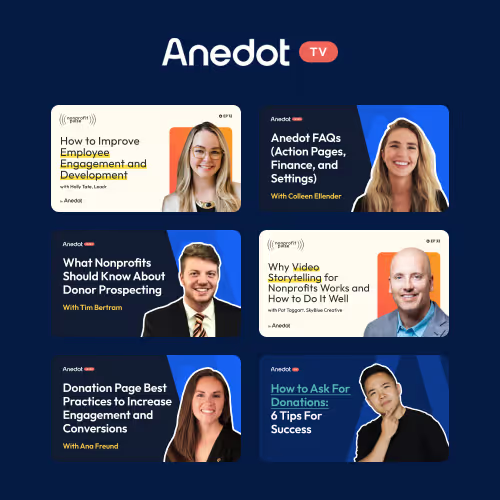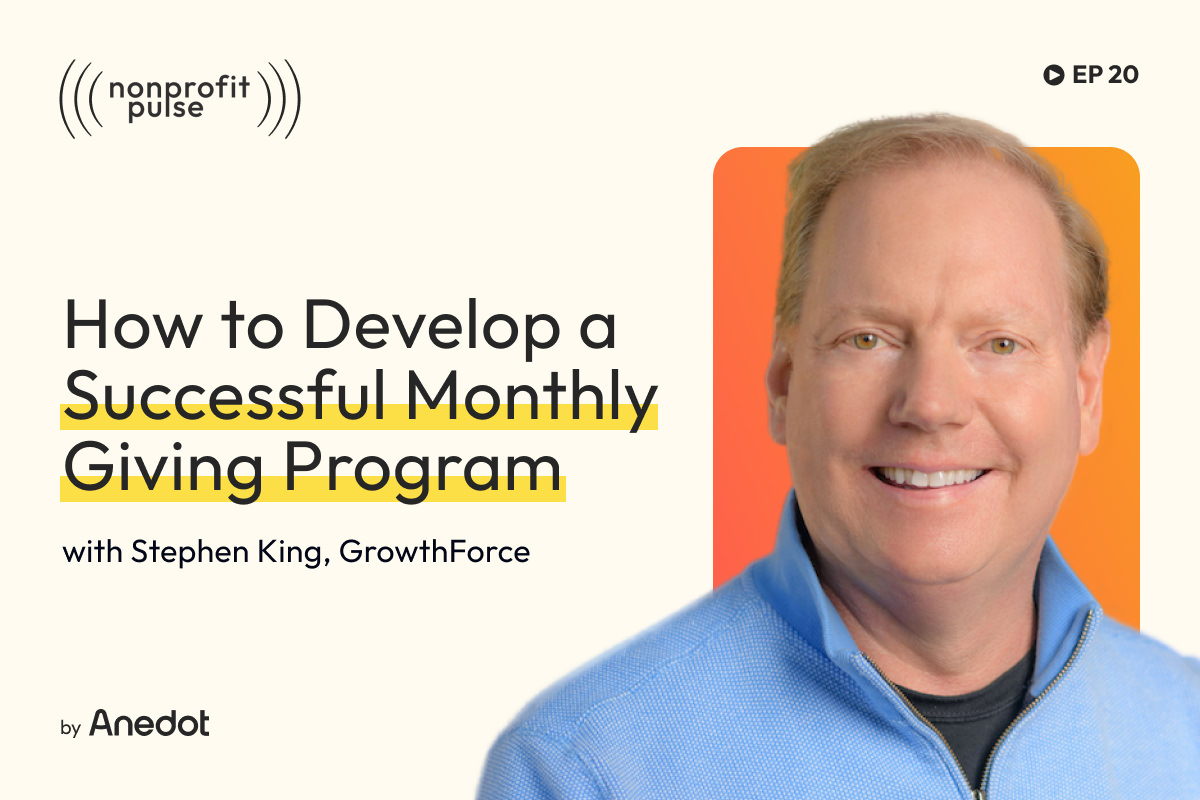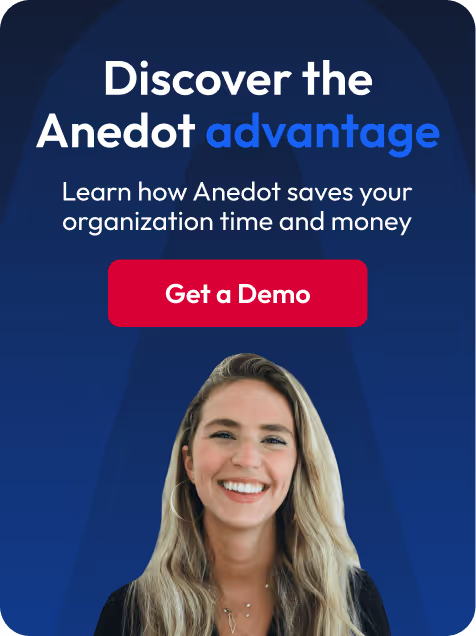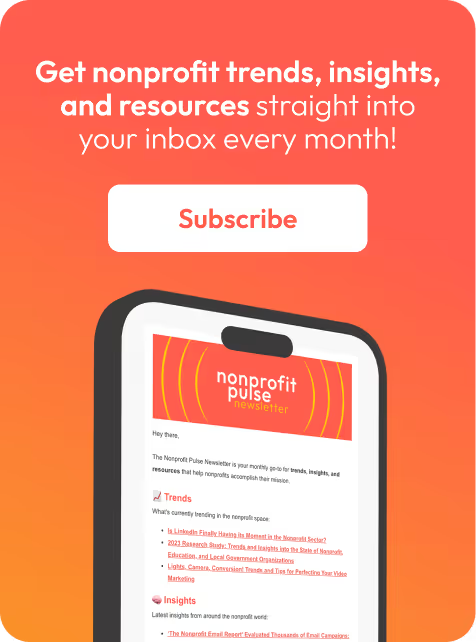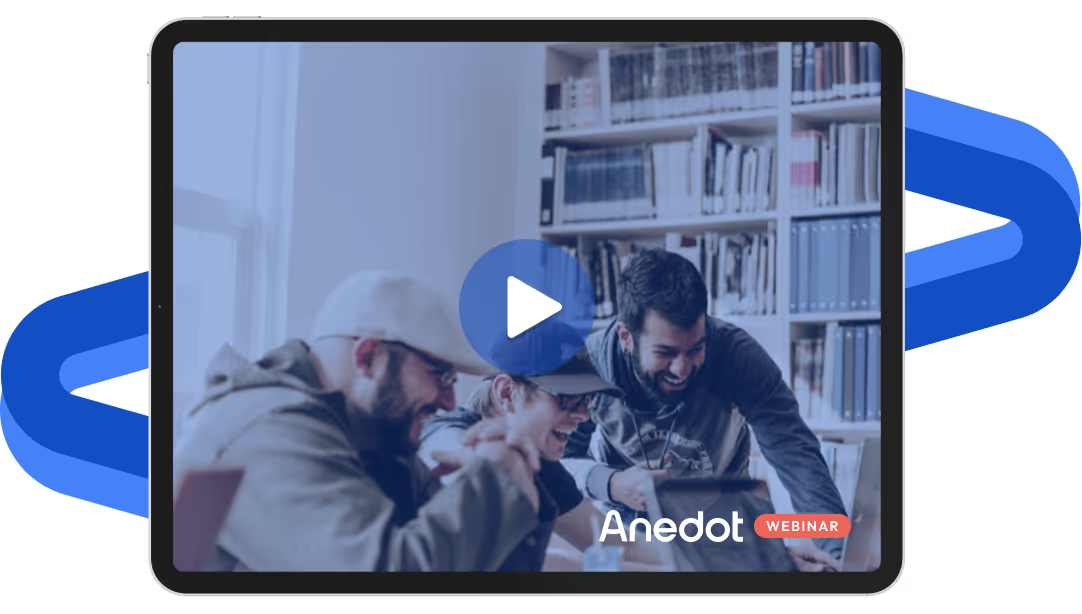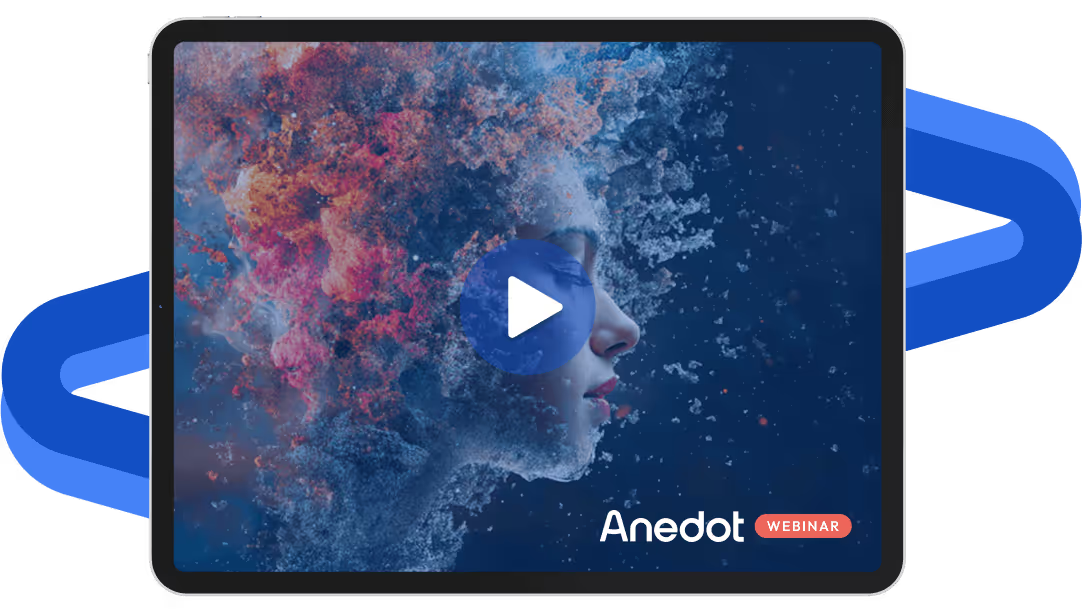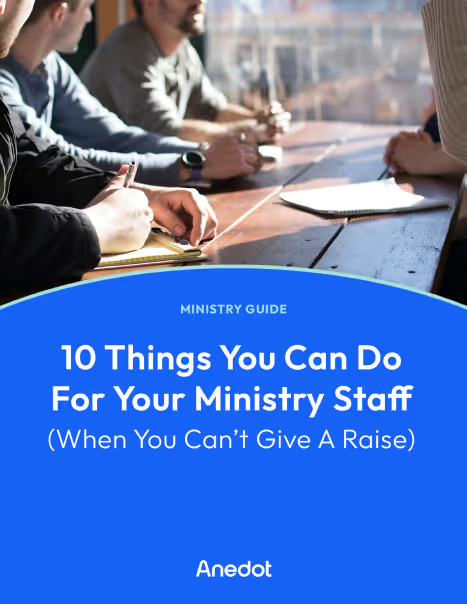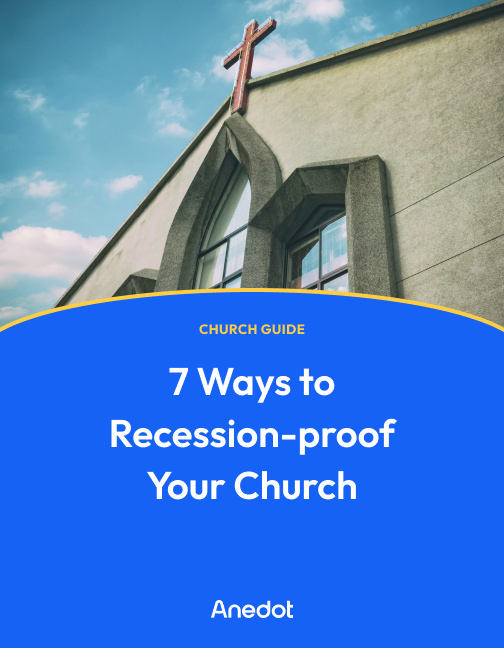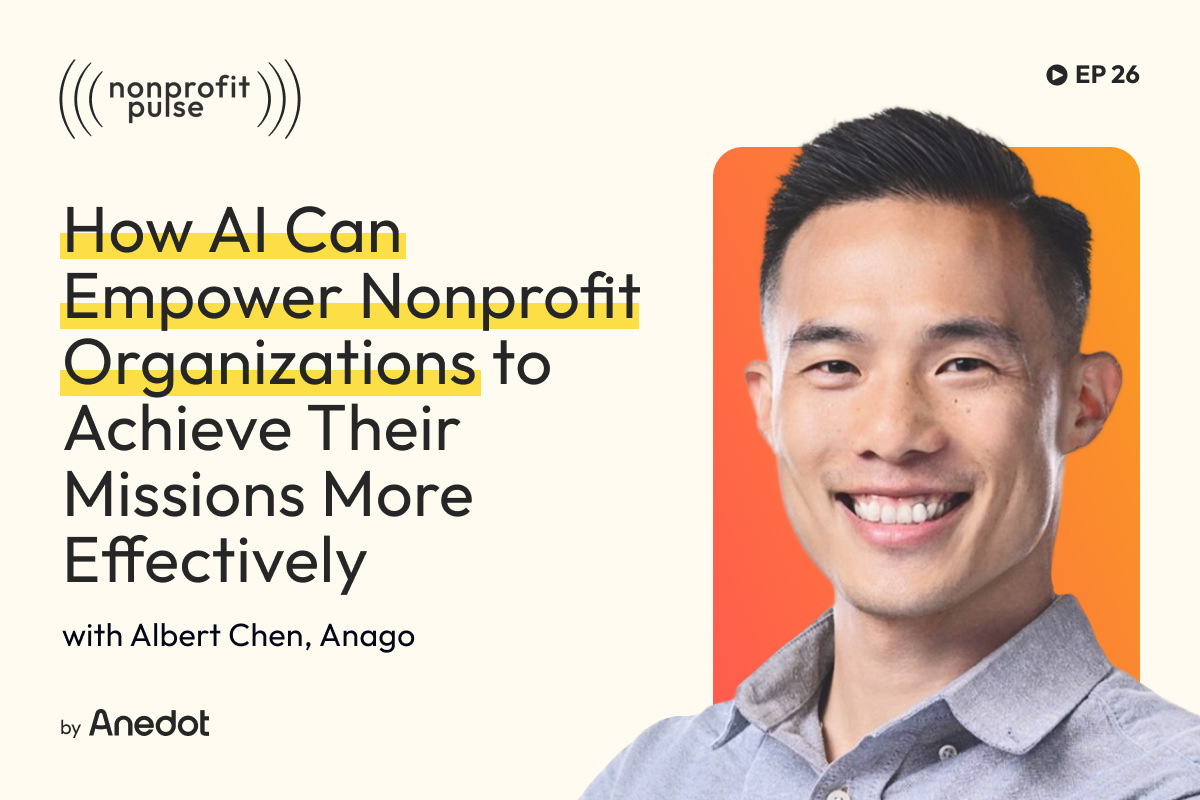Podcast episode transcript ↓
Josh:
A monthly giving program is a sustainable way to fundraise while building a community of loyal supporters for your nonprofit organization.
It’s vital for ensuring long-term success and stability for your nonprofit.
So, how can nonprofits effectively implement and grow the impact of monthly giving programs?
I’m Josh with Anedot, and welcome to Nonprofit Pulse where we explore trends, insights, and resources that help nonprofits accomplish their mission.
On this episode, we are joined by Stephen King on the topic of nonprofit sustainer programs.
Regarded as one of the accounting industry’s top thought leaders, Stephen currently serves as the Founder and CEO of GrowthForce, one of the nation’s largest cloud-based accounting agencies.
From tech founder to nonprofit CFO and fundraiser, Stephen brings a unique combination of vision, foresight, and experience to help nonprofits maximize their cash flow and operational efficiency.
Hey, Stephen, thanks for joining us on Nonprofit Pulse.
Stephen:
Hey, Josh, thanks for having me.
What is a sustainer program?

Josh:
Yeah, so excited today to talk sustainer programs and why your nonprofit needs a sustainer program.
So maybe just starting off, let's define terms.
What is a sustainer program, and really, how does it differ from traditional fundraising operations?
Stephen:
Well, sustainer programs is a fancy word for a monthly giving program.
Donors commit to an amount that they will give automatically every month, either via credit card or a checking account withdrawal.
And it's basically an ongoing, open ended commitment to give you a monthly gift.
What are the benefits of implementing a monthly giving program?

Josh:
Love it. So let's talk benefits.
You know, what's the benefits of implementing a sustainer program for nonprofits, especially when it comes to financial stability and donor retention, which I think are, you know, obviously perennial topics for nonprofits, but very much so right now in this economic climate that we're in.
So what would you say are the benefits of a sustainer program?
Stephen:
Well, number one is creating a predictable, recurring revenue.
The challenge, what we see, in our clients is cash flow is the single biggest issue, especially now as we're getting into the dog days of summer.
You have a lot of giving at year end giving. You may have a spring appeal or a golf outing or something in the first half of the year.
But there's a lot of what we call shark teeth in the giving. Revenue is up and then next month it's down.
By having a monthly giving program, it allows you to be able to create predictable, recurring revenue that helps you better manage cash, allows you to budget, allows you to be able to predictively see how much cash is coming out, and most importantly, it helps you raise more money. The statistics on this are pretty staggering.
How implementing a monthly giving program completely transforms donor retention

Josh:
Yeah. So let's talk about the statistics.
We were talking previously via email about an 80% number. So, thinking about a sustainer program, improving donor retention by 80% in the first year.
Can you share more of the tactics and strategies of that? And tell me the story of that. That's an impressive number.
Stephen:
Yeah. I mean, there's a lot of data out there. Network For Good, The Millennial Impact, Pew Research, have all done research.
Sustainer programs have higher donor retention. You get 80% retention in the first year.
The average across all donors is only 41% in the first year. So that's almost double.
And after five years of monthly giving, the recurring donors have 95% retention.
That's like almost four times higher than one time giving, where there's only a 23% retention. And those retention rates grow stronger over time.
That once a donor decides to become a monthly giver to your organization, they're not going away.
Josh:
Yeah. So we love talking case studies here on the podcast.
Can you share any specific examples or case studies where a nonprofit really had a successful implementation of a new sustainer program and saw that big, spike in donor retention?
Stephen:
Yeah. I mean, I started with this all back in the 1990s when I was the Chief Financial Officer at first for four years and then for three years, became the Director of Development of a nonprofit called Amnesty International USA, world's largest human rights organization.
And as the CFO, I realized that we really needed to have an income diversification program.
And after four years of doing the CFO work and it was right after Bruce Springsteen and U2 and Peter Gabriel, Sting, Tracy Chapman, all this worldwide Human Rights Now tour and Amnesty grew from 6 million to $18 million.
And so my job was to help manage all that growth and put the budgeting systems and all the financial and accounting systems. And I also had fundraising reported to me.
After doing that, I went to the Executive Director, Jack Healey, and said, I'm ready to be Executive Director.
I'm 33 years old and it's time for me to be the boss. And he said, well, you better learn how to raise money.
And two weeks later, and a real God thing, Dianne Feinstein decides to run for Senate.
So tells you how long ago that is. She just retired after 30 years. And I ended up becoming the Director of Development.
And so I realized we needed an income diversification plan because 92% of our revenue came from direct mail.
If you've ever been a member of Amnesty International, you know what those mailings look like.
And one of the things we did was we implemented a partner of conscience program, a monthly giving program.
What we found was that for certain donors, it was really attractive for them to be able to make it extremely easy to be able to give a monthly gift automatically out of their bank account, and know that we are not going to be sending them a lot of other mailings and be part of something special, get some insider information.
It's 2024 when we're recording this, and 35 years later, I'm still giving them 100 bucks a month.
Common challenges of implementing a monthly giving program

Josh:
I love that, I love that, and really just what a story of impact for that organization that is still making a huge difference in the world.
And a lot of that came out of a sustainer program, that some may see as, oh, it's just a shiny object for us, or oh, we tried that and it didn't work.
But let's kind of shift to thinking about challenges that nonprofits are going to face when implementing a sustainer program. And really, how can they overcome these?
So what are some common challenges you see out there, Stephen?
Stephen:
Well, the first, you really have to have a plan and starting with a brand strategy.
It really helps to create something special. Establishing what this group is, giving it a name.
We've got a client called Wheelchairs For Warriors. They created a monthly giving program called Touch 22, and they gave it that name because every day 22 veterans take their lives.
And so by setting up a monthly giving program where donors can give $22 a month, it not only raises money, but it helps raise awareness of a daunting statistic.
By creating a name first, it allows you to understand what this is, partners of conscience. We have another client The Village Learning Center, implemented the Village Builders.
So it's helping you begin to be part of something special. Maslow teaches us we all want to be part of something bigger than ourselves.
And so the first thing is to help identify what is this program, what is it called? And give it a brand that's adjacent to your mission.
The second is, what benefits are you going to offer?
If you treat your donors right, they will be faithful.
So you want to look at including things like connecting with the community, having access to leaders and to be able to get insights into the programs.
Unique access or information that helps you show exactly how their ongoing monthly support makes a difference.
Special events or volunteer opportunities, just allowing somebody to feel like they belong to something bigger than themselves.
Especially now so many of us have gone remote. We need community.
So thinking of ways to connect like minded. And then settling on some messages that will attract the donors.
You know the key, the secret to everything we do is about helping show the donor the tangible result of their gift.
And so what I love most about the monthly giving programs is it gives you an opportunity to put a communication strategy and do a storyboard and that kind of outline.
What are we going to tell our donors over the course of this year? How are we going to show them what we did with their investment?
So the monthly giving program is not only a predictable cash flow, but it's also a way to build that connection with the donors.
To be able to have regular cultivation mailings and acknowledgment letters and stewardship mailings that will let them get connected to the organization in a way that's very difficult when you only have an annual gift.
How to promote a monthly giving program

Josh:
I love that and thinking through just more about communications.
I'm a former Communications Director, and I've worked closely in communications and giving.
And so there might be some bias here, but I would just say that communications is really everything when it comes to giving programs.
Poor communication, poor brand work, as you mentioned, those are all hurdles that really cause friction and a lower conversion rate when it comes to giving.
What can you share with us about how to effectively communicate about these monthly programs, sustainer programs?
Any tips or tactics that really land on the supporter, the donor in a powerful way?
Stephen:
Yeah, I think you said it well, Josh, I think you have to have a communication strategy first.
I like to think of it like a storyboard.
Anybody who's ever done a newsletter or has a blog or a social media strategy outlines the messaging that you want to give in advance. It's the same thing here.
And so what you want to be thinking about is how do you communicate in your mailing? If you're doing direct mail or emails. In your social media?
And what are the opportunities to integrate that messaging into the other things that you're doing?
How do you talk about sustained giving on your website, for example?
Those are your best donors and having that message linked everywhere helps you grab some of those donors in the places they already are.
For example, on your website, your donate button should have a sustained giving form or use a pop up, on your existing form, to make it easy for someone to be able to opt in with a recurring gift.
Statistics show that the best chance to convert a one time donor to a sustainer donor is at the time of their first gift.
So when you're getting that first gift, use your website or whatever conversion tools you got, your email, your social media, your direct mail, to help convert those donors.
Essential metrics for tracking and growing a monthly giving program

Josh:
Transitioning to something you kind of alluded to in your answer just now, metrics.
Nonprofits really need to measure what matters, but oftentimes it's confusing or there's disagreement on the teams about what should we be measuring, what should our KPIs be.
Or just even in general, just what metric should we even be looking at?
So what key metrics would you suggest for nonprofits to track and watch for their sustainer programs and growing those programs?
Stephen:
Well, first, I think it's helpful to understand some of the statistics and metrics that are out there in the industry about why this is so important.
According to MatchPro, 14% of nonprofits prompt their donors to make a recurring gift during that donation process.
So it's a real small percentage, right? And in the surveys you talk about 94% of recurring donors would prefer to give monthly.
It makes it easy for them to budget, to be able to understand where their money is going to and how much it's going to cost them.
There's no surprise. It's like, hey, do we want to give $1,000 check to this charity at the end of the month? Well, you don't have that, at the end of the year?
You don't have that on your budget. So the shocking answer here first is that you have a large number of donors who want to do it and a small number of donors who make it easy.
But in terms of measurement, we do outsourced accounting for small nonprofits, for medium sized nonprofits.
And so it's all about data. Everything we do is about making data driven decisions.
So as you start to build your monthly giving program, you want to make sure that you know, what's the criteria for getting someone to be a monthly giver?
How will you activate those? And then how will you deactivate them if they don't continue to pay?
How will you accept the payment? Is it credit card payment or can you debit their bank account?
Because credit cards change. I seem to be getting hacked more and more.
So, I feel like one of the biggest lessons here is to use the bank debit instead of the credit card, so that you don't ever have to go chase the donors.
→ P.S. Stop losing recurring donors with our credit card auto-updater. Check out our Credit Card Updater feature!
In terms of your metrics for how you measure success of this, it's all about the donor’s lifetime value, right?
What is the lifetime value of your donor?
So when you have somebody who is giving you a monthly gift, you're going to have a longer life with them.
And so those donors should be captured and measured separately, so you can see, is the value of those donors going up?
Then your second measure is looking at the retention rate.
What is the turnover of those donors and how does that compare to your regular donors?
I also like to look at response rate. What's the click through rates? What are the email opens on the monthly givers versus your regular givers?
If your donors are used to getting meaningful, a program data, and everything I would suggest is in the first person.
I wish you could have been with me at the top of the stairs when Mary Jo came to me and said, I've got my son back. I'm so excited because they were taken away because they were in the homeless shelter and now because of the homeless program, they were able to have their family back together. Right?
Those emails, those cultivation emails, will connect your donors greater than anything else.
So looking at response rates is really important because that'll tell you how effective you are in that messaging, because you don't need to do any solicitation in those emails.
You're already debiting their bank account on the first of the month, so your emails get to be more targeted.
And then what's the ratio of recurring donations versus one time gifts, and rates of upgrading people?
Those are the things that we suggest most people look at.
Should nonprofits launch multiple monthly giving programs?

Josh:
Just following up on that, it got me thinking about multiple sustainer programs depending on how wide your program portfolio is at your nonprofit.
What have you seen with as far as success for nonprofits who are running kind of multiple programs or, sorry, multiple sustainer programs at once? So, for instance, you mentioned the veterans one.
There may be another program they could launch on the sustainer program that's serving those who are just getting out of the military.
And we want to serve 10 a month or a 100 per month. How have you seen those work?
Do you see them more as competing against one another, or is it really a tide that kind of raises all ships?
Stephen:
I'm not seeing a lot of organizations with multiple sustainer programs because, this is not a set it and forget it program, right?
You don't just turn on a sustainer program and you sign up your monthly recurring donors, and then you don't have to worry about them.
Like I mentioned, you really need to have a storyboard and a communication strategy where you're going to be showing them the tangible results of their gift.
You gave us $100 each month, and here's what we did with it.
You paid for one person to sit on the bus to be able to have one of our adults with learning disabilities to go to their job.
So thank you. Here's a picture of Josh getting on the bus or whatever your measure is.
That's what that we like to focus on at GrowthForce is showing the donor the tangible results of the gift.
Most of our organizations which, you know, in that 2 to $20 million in revenue don't have the resources to have multiple sustainer programs, Josh. So I don't see a lot of that.
And I think what's also key is less is more. Really focusing on doing a great job for the right potential sustainer donors, that's what I would focus on.
Certain donors are more likely to sign up for sustainer programs than others. I would focus on getting that right.
Josh:
Yeah, I love that.
And it just makes me think of how focused, having your kind of primary, one singular, sustainer program that's based on kind of your core offering, your core program at your nonprofit.
That is connected to your brand, that is connected to your brand promise and all these things where it just creates this, very clear and compelling vision of what your dollar is going to.
Because, yes, it's going to the program. It's going to the nonprofit, more broadly, but it's going to this core program offering that's helping people in communities.
And I think that's just super compelling.
Stephen:
Exactly. I completely agree. Keep it simple too.
People are busy, so you want to, it's short, these are not three page emails.
It's three paragraphs at most and just a picture. And, just share the emotion, right? First person messages.
I love, like I said, I wish you could’ve been with me. And then show them, more than tell them.
How to get started with launching a monthly giving program

Josh:
Love it. Stephen, thinking about those in our audience who may want to take a next step in starting a sustainer program at their organization, what would you say initial steps, for them to take, whether they're small, medium sized, large?
What would you recommend?
Stephen:
Well, I think the key is segmenting your donors.
Starting with looking at gift size or geographic or the area of interest.
Then set some guidelines on how you tailor your message towards that sustainer message.
Certain donors, like I mentioned, are or more likely to become sustainer donors.
Specifically, recent donors or donors who have recently lapsed are more likely to convert to sustainer gifts, to monthly giving, than than all other.
So, look at your donor management system and just segment the donors.
Now what I find is this is not something that you want to go to your very top donors with.
You're not looking to go to somebody who's giving you 10,000, 50,000 or more. Because you want to keep that as a personal solicitation, right?
Your Executive Director or a member of the board have a relationship with those donors, and we're going to go visit them and show them the tangible result of their gifts, face to face.
This is more for the smaller donors, right? Someone who gave you 500 bucks is a great example.
What I suggest is you take that $500 annual giver, and this is what we did at Amnesty, we dropped off the last zero.
So now it's 50 bucks. And we asked to give that much each month.
And you explain to them what the benefit of is having predictable, recurring revenue to allow us to be able to make sure that we can make payroll.
Donors don't like to pay for payroll, and they don't like to pay for lights.
They like to pay for the outcomes. That person's payroll achieves, right?
But allowing us to have predictable cash flow is something that everybody understands in order to make sure that we can make a commitment and keep it and we can start programs and continue it to the end.
But that idea of taking someone who's got $100 and $200 gift dropped the last zero and ask them to give you $20 a month.
And what that means is you get an instant 20% increase.
Somebody gave you $500 a year. Well, now, if you're asking them for $50 a month, they're giving you $600. So it's 20% more.
And if you get them into that monthly giving program, then you have a better chance to upsell them going forward.
Closing thoughts

Josh:
I love that.
Last question, Stephen. If you were standing on stage in front of 1,000 nonprofit leaders and you could share one thing with them, one sentence regarding sustainer programs, what would you say?
Stephen:
I think this is one of the easiest ways to raise more money and help solve the cash flow problem.
Like we mentioned earlier on, the statistics are staggering.
This is what donors want to do. And what's interesting is particularly around the millennials, they really want to have monthly giving, right?
And now we're starting to get to the point where the millennials have overtaken the baby boomers and make up the largest living generation of adults. 52% of millennials want to give monthly giving as opposed to one large donation.
So you really have an opportunity here to improve your cash flow, have more predictable resources just by making it easy for the donor to give to you every month. It's a no brainer.
Josh:
And bringing in so many new supporters who are going to be advocates for your organization, who are going to share the impact with their friends. I mean, just a network effect, too, of just having more people who are supporting your organization regardless of dollar amount is powerful.
→ P.S. Enhance your donation forms by adding a simple pop-up that asks one-time supporters to give on a monthly basis. Check out our Upgrades feature!
Stephen:
Exactly.
Awesome. Steve. And, resources, any resources you recommend to our audience on sustainer programs or really any other areas?
Stephen:
Yeah. GrowthForce is an outsourced accounting department for nonprofits that covers everything from the basic bookkeeping all the way up to our CFO services.
And on our website, under our CFO services, we have finance and accounting and fundraising. And I am the fundraising accountant.
So Growthforce.com. That's Growthforce.com/nfp. For not for profit.
And that will allow you to be able to get access to a lot of our resources.
Like we have a nonprofit reporting e-book and an Executive Director’s guide to board and management reports that shows you exactly what you can give your board in order to keep them at a strategic level, and what you, as an Executive Director and the leadership team need in order to be able to make data driven decisions.
So Growthforce.com/nfp.
Josh:
Love it.
And as always you can find these links on the episode show notes at Nonprofitpulse.com.
Stephen, thanks for the great conversation. Super excited to get this out.
And I hope our audience takes the next step or reimagines their current program.
But again, thank you so much for sharing with us.
Stephen:
My pleasure, Josh. Thanks for having me.
Josh:
Hey, thanks for listening.
If you enjoyed this conversation, please share or leave us a rating and review wherever you listen to podcasts.
Also, head on over to Nonprofitpulse.com to sign up for our monthly newsletter, as well as check out all the links and resources in the show notes. We’ll see you next time.
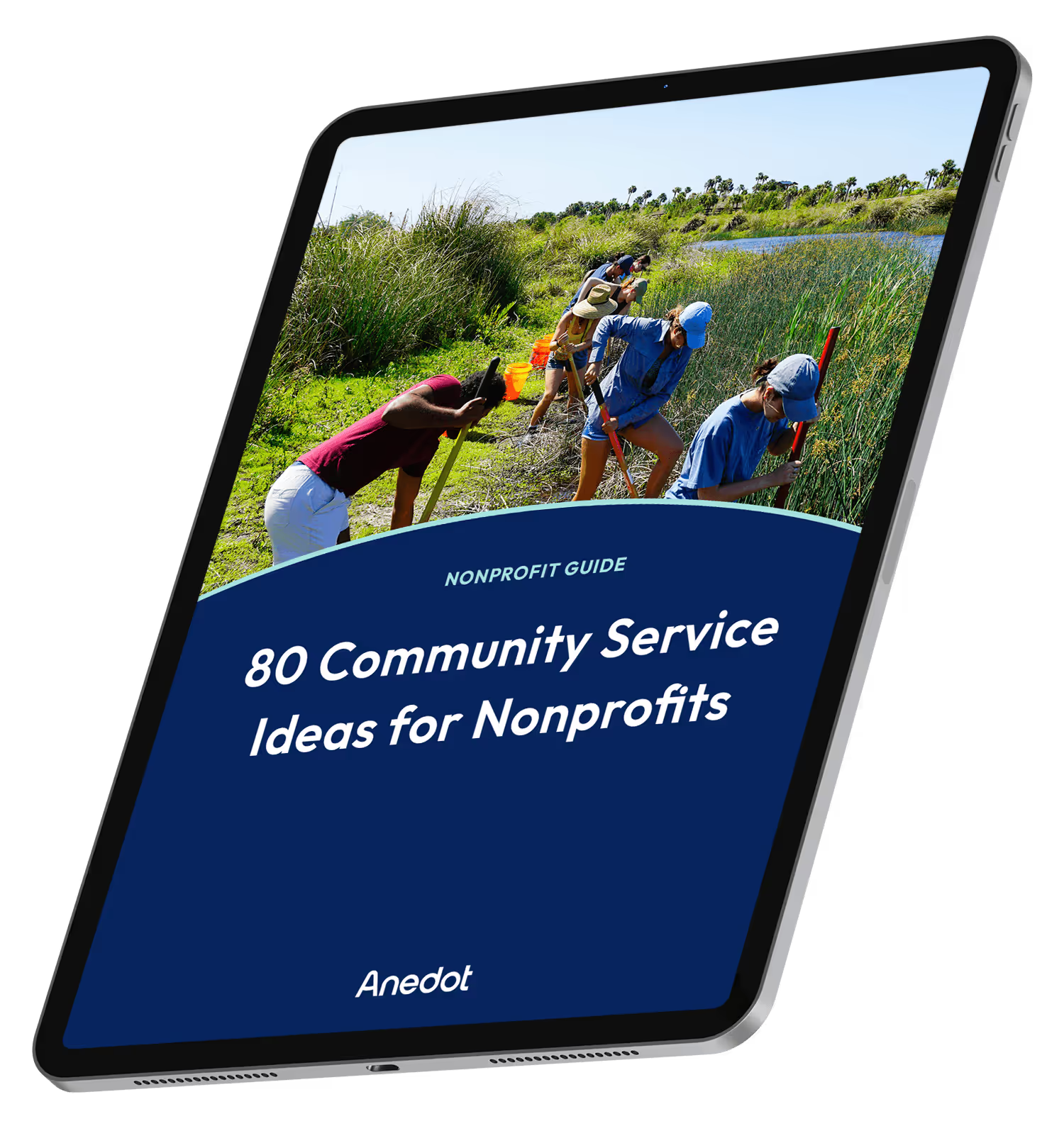
80 Community Service Ideas for Nonprofits

